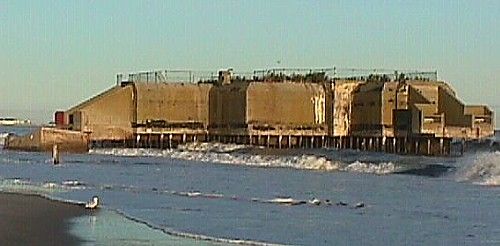2008.01.31 14:22
the architecture of war
Yes, human nature.
According to The Bible, the first human death was a murder.
3333z
2008.01.31 13:02
the architecture of war
War and peace at the southern-most tip of New Jersey.

My elderly next door neighbor was in the homefront Navy during WWII, and tells of German U-Boats regularly off the New Jersey coast. Apparently, some German sailors bought bread in Atlantic City--among the debris from a hit German submarine somewhere in the Atlantic were wrappings of American bought bread.

pilotis wo bist du?
3333z
| |
To think of the architect as a producer is to renounce almost entirely the traditional baggage of values and judgments. As an entire production cycle rather than a single work is desired, critical analysis must be directed towards the material constraints which determine the production cycle itself. Yet this is not enough. The specific analysis must be made compatible with the dynamics of the entire economic
cycle, not to generate those misunderstandings brought about by an economic vision subordinated to the needs of architecture. In other words, to change the scope of what architecture wishes to be, or wishes to say, towards that which building construction is in reality, means that we must find suitable parameters which will allow us to understand the role of construction within the entire capitalistic system. It may be objected such an economic reading of building production is other then the reading of architecture as a system of communications. We can only answer that, wishing to discover the tricks of a magician, it is often better to observe him from behind the scenes rather than to continue to stare at him from a seat in the audience.
It is clear then that to place architectural ideology into the production cycle, albeit as a secondary element, is quite simply to overthrow the pyramid of values which are usually accepted in the consideration of architecture. Once such a judgment standard has been accepted, however, it will be quite ridiculous to ask in which way a linguistic choice or an element of structural organization will express or anticipate "more free" ways of life. That which criticism must ask of architecture is in what way will it, insofar as it is a precise
orgenization, be able to influence the relations of production. We therefore find it important here to grasp certain questions which Benjamin posed in one of his more important essays, "The Author as Producer."
Now instead of asking what is the position of a work with respect to the relations of production of an era, if it is in accord with them, if it is reactionary or if instead it aims at their overthrow, if it is revolutionary; instead of asking this question or at least before asking it, I would like to ask another. Therefore, before asking what is the position of a poem with respect to the relations of production of the era, I would like to ask what is its position within them? This question directly concerns the function of the work relative to the relation of literary production of an era. In other words, it is a question immediately aimed at the literary techniques of these works.37
This viewpoint is for Benjamin, in fact, a radical step ahead of his own more ideological positions, such as those expressed in the conclusions to Opera d 'A rte nell'epoca delia sua riproducibilita tecnica. Among the questions posed in "The Author as Producer," there are no concessions to proposals for salvation by means of an "alternative" use of linguistic elements, no ideology beyond a "communist" art as opposed to a "fascist" art. There is only a structural consideration--authentically structural--of the productive role of intellectual activities, and therefore certain questions regarding their possible contribution to the development of the relations of production. There are certainly many obscure points in Benjamin's text concerning the political value of certain technical innovations--we are thinking of the connections traced between Dadaism and the content of a political photomontage by Heartfield38--considered "revolutionary" by Benjamin. Yet the substance of his argument is vital today, so much so as in fact to lead to a radical revision in the recognition of fundamental turning points in the history of contemporary art and architecture. Keeping in mind the central question--that is, what is the position of the work of art within the relations of production--many "masterpieces" of modern architecture take on a secondary if not altogether marginal significance, while a great deal of the current debates will be relegated to the periphery.
|

